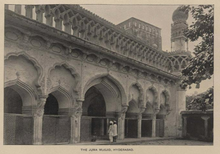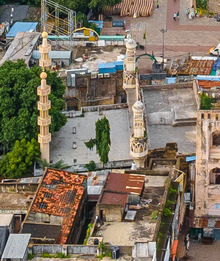| Revision as of 14:52, 4 January 2025 editAmateurHi$torian (talk | contribs)Extended confirmed users2,461 editsNo edit summaryTag: Visual edit← Previous edit | Revision as of 14:58, 4 January 2025 edit undoAmateurHi$torian (talk | contribs)Extended confirmed users2,461 editsNo edit summaryTag: Visual editNext edit → | ||
| Line 14: | Line 14: | ||
| == Background == | == Background == | ||
| The city of ] was established in the late 16th century by ], the fifth sultan of the ]. The Jama Masjid was built in 1597–98, and was the first mosque to be built in Hyderabad. Prior to its establishment, prayers were held in a small prayer-hall on the first floor of the ]. It was intended to be the ] of the new city. It served this purpose in the initial period after the city's founding, when its population was small. Later, the much larger ] was built to accommodate the city's growing population. The mosque underwent heavy restorations in the 19th century, during the rule of ].<ref name=":0">{{Cite book |last=Bilgrami |first=Syed Ali Asgar |url=https://archive.org/details/in.ernet.dli.2015.63136/page/n49/mode/2up |title=Landmarks Of The Deccan |date= |publisher=Government Central Press |year=1927 |location=Hyderabad-Deccan |pages=26–29}}</ref><ref>{{Cite book |last=Haig |first=Thomas Wolseley |url=https://en.wikisource.org/Historic_Landmarks_of_the_Deccan |title=Historic Landmarks of the Deccan |page=210}}</ref><ref name=":4">{{Cite book |last=Sherwani |first=Haroon Khan |author-link=Haroon Khan Sherwani |url=https://ia601506.us.archive.org/25/items/in.ernet.dli.2015.56608/2015.56608.Muhammad-quli-Qutb-Shah-Founder-Of-Hydarabad_text.pdf |title=Muhammad-Quli Qutb Shah, Founder of Haidarabad |publisher=Asia Publishing House |year=1967 |pages=28-29}}</ref> | The city of ] was established in the late 16th century by ], the fifth sultan of the ]. The Jama Masjid was built in 1597–98, and was the first mosque to be built in Hyderabad. Prior to its establishment, prayers were held in a small prayer-hall on the first floor of the ]. | ||
| The mosque was constructed at a cost of 200,000 ]. It was intended to be the ] of the new city. It served this purpose in the initial period after the city's founding, when its population was small. Later, the much larger ] was built to accommodate the city's growing population. The mosque underwent heavy restorations in the 19th century, during the rule of ], and some scholars speculate that the ] arches on the facade were added during this period.<ref name=":0">{{Cite book |last=Bilgrami |first=Syed Ali Asgar |url=https://archive.org/details/in.ernet.dli.2015.63136/page/n49/mode/2up |title=Landmarks Of The Deccan |date= |publisher=Government Central Press |year=1927 |location=Hyderabad-Deccan |pages=26–29}}</ref><ref>{{Cite book |last=Haig |first=Thomas Wolseley |url=https://en.wikisource.org/Historic_Landmarks_of_the_Deccan |title=Historic Landmarks of the Deccan |page=210}}</ref><ref name=":4">{{Cite book |last=Sherwani |first=Haroon Khan |author-link=Haroon Khan Sherwani |url=https://ia601506.us.archive.org/25/items/in.ernet.dli.2015.56608/2015.56608.Muhammad-quli-Qutb-Shah-Founder-Of-Hydarabad_text.pdf |title=Muhammad-Quli Qutb Shah, Founder of Haidarabad |publisher=Asia Publishing House |year=1967 |pages=28-29}}</ref> | |||
| == Description == | == Description == | ||
| The mosque is an important example of early ]. It stands at the western end of a paved courtyard, which measures {{Dimensions|74|70}} feet. It is accessible through a portal of the ]-and-] form, which leads to a narrow lane, from which one approaches the side of the mosque. The courtyard contains a cistern at its north-eastern end. A narrow ], consisting of nine openings, runs along the north of the courtyard.<ref name=":2">{{Cite book |last=Yazdani |first=Ghulam |author-link=Ghulam Yazdani |url=https://archive.org/details/in.ernet.dli.2015.90887/page/n71/mode/2up |title=Epigraphia Indo-Moslemica, 1917-18 |date=1921 |publisher=Superintendent Government Printing, India |location=Calcutta |pages=43-45}}</ref><ref name=":3" /> | The mosque is an important example of early ]. It stands at the western end of a paved courtyard, which measures {{Dimensions|74|70}} feet. It is accessible through a portal of the ]-and-] form, which leads to a narrow lane, from which one approaches the side of the mosque from the west. This is different from all other mosques of this period, where the entrance is at the front. The courtyard contains a cistern at its north-eastern end. A narrow ], consisting of nine openings, runs along the north of the courtyard.<ref name=":2">{{Cite book |last=Yazdani |first=Ghulam |author-link=Ghulam Yazdani |url=https://archive.org/details/in.ernet.dli.2015.90887/page/n71/mode/2up |title=Epigraphia Indo-Moslemica, 1917-18 |date=1921 |publisher=Superintendent Government Printing, India |location=Calcutta |pages=43-45}}</ref><ref name=":3" /> | ||
| The |
The facade features seven arches, each composed of two sections. The lower section of each arch is an arched entrance, with the upper section resting on struts that project from the ]. The central arch is wider and taller than the others, and its upper section consists of a ] arch. In contrast, the upper sections of the remaining six arches are ]. A stone ] resting upon ] runs above the arches. Finally, an ornamental ] rises above the facade. The prayer-hall is flat-roofed.<ref name=":3">{{Cite book |last= |url=https://archive.org/details/in.ernet.dli.2015.153598/page/n307/mode/2up |title=History Of Medieval Deccan |date=1974 |editor-last=Sherwani |editor-first=Haroon Khan |editor-link=Haroon Khan Sherwani |pages=299 |editor-last2=Joshi |editor-first2=P. M.}}</ref> | ||
| Each front corner has circular ], upon which the front minarets are placed. The minarets are square, each topped with a small tomb-like structure. The short height of the minarets was perhaps deliberate, in order to emphasize the loftiness of the nearby ] and ]. The interior consists of a double hall, measuring 72', 6" in length and 32', 6" in breadth. The mosque can accommodate about 750 worshippers.<ref name=":3" />] | Each front corner has circular ], upon which the front minarets are placed. The minarets are square, each topped with a small tomb-like structure. The short height of the minarets was perhaps deliberate, in order to emphasize the loftiness of the nearby ] and ]. The interior consists of a double hall, measuring 72', 6" in length and 32', 6" in breadth. The mosque can accommodate about 750 worshippers.<ref name=":3" />] | ||
Revision as of 14:58, 4 January 2025
Mosque in Hyderabad| Jama Masjid, Hyderabad | |
|---|---|
 Jama Masjid, circa 1898 Jama Masjid, circa 1898 | |
| Religion | |
| Affiliation | Islam |
| Location | |
| Location | Hyderabad, Telangana, India |
| Architecture | |
| Style | Qutb Shahi |
The Jama Masjid is a mosque located in Hyderabad, in the Indian state of Telangana. It is situated to the northeast of the Charminar at a short distance, approached by a narrow lane. It was built in 1597–98, around the same time as the founding of Hyderabad, and was the first mosque to be built in the city.
The mosque is located within a courtyard, which also contains a hammam and a cistern. Its facade contains seven arched entrances leading into the prayer-hall, and is flanked by two minarets. The inscriptions located on the exterior and within the interior of the mosque are considered to be of high artistic merit. It can accommodate about 750 worshippers.
Background
The city of Hyderabad was established in the late 16th century by Muhammad Quli Qutb Shah, the fifth sultan of the Golconda Sultanate. The Jama Masjid was built in 1597–98, and was the first mosque to be built in Hyderabad. Prior to its establishment, prayers were held in a small prayer-hall on the first floor of the Charminar.
The mosque was constructed at a cost of 200,000 rupees. It was intended to be the congregational mosque of the new city. It served this purpose in the initial period after the city's founding, when its population was small. Later, the much larger Mecca Masjid was built to accommodate the city's growing population. The mosque underwent heavy restorations in the 19th century, during the rule of Asaf Jah III, and some scholars speculate that the cusped arches on the facade were added during this period.
Description
The mosque is an important example of early Qutb Shahi architecture. It stands at the western end of a paved courtyard, which measures 74 × 70 feet. It is accessible through a portal of the pillar-and-lintel form, which leads to a narrow lane, from which one approaches the side of the mosque from the west. This is different from all other mosques of this period, where the entrance is at the front. The courtyard contains a cistern at its north-eastern end. A narrow collonade, consisting of nine openings, runs along the north of the courtyard.
The facade features seven arches, each composed of two sections. The lower section of each arch is an arched entrance, with the upper section resting on struts that project from the piers. The central arch is wider and taller than the others, and its upper section consists of a pointed arch. In contrast, the upper sections of the remaining six arches are cusped. A stone chajja resting upon brackets runs above the arches. Finally, an ornamental parapet rises above the facade. The prayer-hall is flat-roofed.
Each front corner has circular buttresses, upon which the front minarets are placed. The minarets are square, each topped with a small tomb-like structure. The short height of the minarets was perhaps deliberate, in order to emphasize the loftiness of the nearby Char Kaman and Charminar. The interior consists of a double hall, measuring 72', 6" in length and 32', 6" in breadth. The mosque can accommodate about 750 worshippers.

Inscriptions
A Persian inscription in the Nastaliq script is carved into a black basalt tablet above the main entrance. It contains verses praising Allah, and notes that the mosque was constructed under the supervision of a nobleman named Amin-ul-Mulk. It contains a chronogram, dating the mosque to 1006 Hijri (1597–98 CE). This inscription is considered to be of very high calligraphical merit, and is praised by scholars including H. K. Sherwani and Ghulam Yazdani, the latter of whom calls it "finest example of the Nastaliq script in the Deccan", and says that it may compare favorably with the best calligraphic specimens of other countries.
The second inscription is located in the western wall of the prayer hall, above the mihrab. It contains the verses 137 and 138 of the second chapter of the Quran, inscribed in the Thuluth script, along with the name of the artist and the year of inscription.
References
- Khalidi, Omar (2009). A Guide to Architecture in Hyderabad, Deccan, India (PDF). p. 40. Archived from the original (PDF) on 2020-03-13.
- Campbell, A. C. (1898). Glimpses of the Nizams Dominions. pp. 168–169.
- "Hyderabad's first Jama Masjid remains consigned to oblivion". The Times of India. 2017-09-10. ISSN 0971-8257. Retrieved 2023-07-23.
- ^ Sherwani, Haroon Khan (1967). Muhammad-Quli Qutb Shah, Founder of Haidarabad (PDF). Asia Publishing House. pp. 28–29.
- ^ Bilgrami, Syed Ali Asgar (1927). Landmarks Of The Deccan. Hyderabad-Deccan: Government Central Press. pp. 26–29.
- Haig, Thomas Wolseley. Historic Landmarks of the Deccan. p. 210.
- ^ Yazdani, Ghulam (1921). Epigraphia Indo-Moslemica, 1917-18. Calcutta: Superintendent Government Printing, India. pp. 43–45.
- ^ Sherwani, Haroon Khan; Joshi, P. M., eds. (1974). History Of Medieval Deccan. p. 299.
| Qutb Shahi architecture | |
|---|---|
Categories: